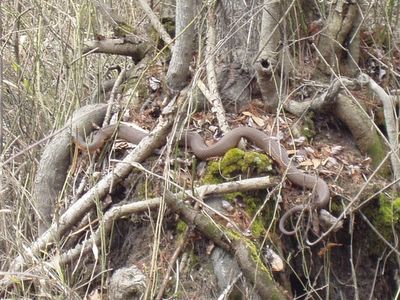If my husband's not on duty, we usually go wandering after I finish my water monitoring on Sunday mornings. Today we wandered over to a nearby borrow pit. In these parts it pays to be particular about where you put your feet. In the past we have seen numerous cottonmouths in and around this particular borrow pit. Today was no exception -- we found five Eastern Cottonmouths (
Agkistrodon piscivorus piscivorus).
Most folks around here think every snake they see, particularly around the water, is venomous. That's just not so. The cottonmouth (a.k.a. water moccasin) is our
only venomous water snake. It is one of the three venomous snakes found here. The others are the copperhead (
Agkistrodon contortrix) and the canebrake rattlesnake (
Crotalus horridus). [The coral snake (
Micrurus fulvius), another venomous species, can be found in the southern coastal plain of North Carolina.]
We like snakes, all snakes. They are very important in maintaining a healthy ecosystem. If you respect a snake's personal space and pay attention to what you're doing, you won't get bitten. I never handle venomous snakes and I handle the non-venomous ones with care. Snakes are often misunderstood and feared. It really bothers me when I hear someone say, "The only good snake is a dead snake." What a horrible attitude to have toward a truly amazing animal.

























